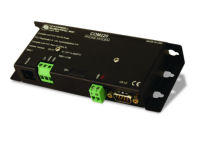The COM220 modem enables communications between a computer and a Campbell datalogger via a public switched telephone network. A Hayes-compatible modem is required at the base-station computer while a COM220 connects to the datalogger at the field site. The COM220's wide operating temperature range and minimal power requirements make it ideal for use at remote sites. A surge protector to help suppress incoming electrical transients carried down the phone line is strongly recommended.

Features
Improvements over its predecessor, the COM210, include:
Supports communication rates up to 115.2 kbps between modem and logger. (In practice, data transmission through phone lines is generally constrained to 33.6 kbps.)
Offers both modem enabled (ME) and synchronous device communications (SDC) modes.
Allows user to set the number of rings before answering call.
Specifications
Standards: V.92, K56Flex, V.90, V.34, V.32bis, V32, V23, V22bis, V22, V.21, B212, B103
Registration
FCC US: 3A4M508BSM2-T-W
IC 2377 A-SM2TW
TBR21
Operating Voltage: 12 Vdc
Current Drain
Quiescent: ~12 μA
Active: ~30 mA
Communication Rate Between Datalogger and COM220 (selected by user): 9600, 38400, 57600, 115200 bps
Operation: Full-duplex over standard analog phone lines
Producing Area:USA